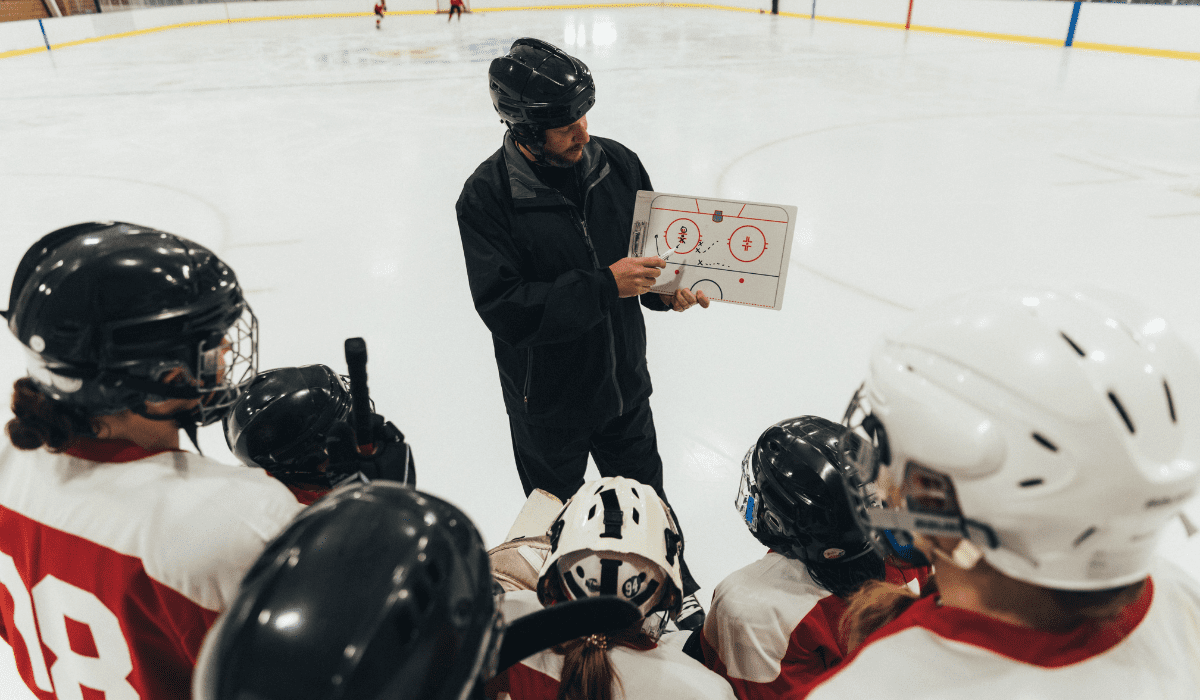Understanding A Hockey Assist Definition: A Detailed Guide
A hockey assist is a pass that directly leads to a goal but is not the primary pass leading to the goal.
Ice hockey is a dynamic and fast-paced sport that requires teamwork, skill, and strategy. One essential element of gameplay that may not receive as much recognition as it deserves is the hockey assist. In this comprehensive guide, I will delve into the hockey assist definition, explore its meaning and role in gameplay, and highlight its importance for individual and team success.
A hockey assist may not be the primary pass leading to a goal, but it is a critical element of the scoring sequence. Understanding its definition and importance can increase players’ overall game understanding, contribute to team success, and enhance individual skills.
Key Takeaways
- A hockey assist is a pass that directly leads to a goal but is not the primary pass leading to the goal
- It showcases the pass made immediately prior to the primary assist and demonstrates teamwork, vision, and passing skills
- The hockey assist is an indicator of a player’s ability to make smart passing decisions and contribute to overall team success
- Coaches in youth hockey can instill the value of the hockey assist to promote a positive and team-oriented mindset in young players
- The hockey assist exemplifies good sportsmanship and promotes a culture of respect, teamwork, and recognition for collective efforts on the ice
What is a Hockey Assist?
In this section, I will dive into the definition of a hockey assist. A hockey assist refers to a pass that directly leads to a goal, but it is not the primary pass leading to the goal. In other words, the player who makes the hockey assist play sets up the primary assist. A primary assist is the pass that immediately precedes the goal scorer’s shot, and it is recorded on the scoresheet as an official assist.

While the primary assist gets recognition in the scoring sequence, the hockey assist is equally critical to the game. It showcases the importance of team play, vision, and passing skills. Making a successful hockey assist requires players to demonstrate exceptional teamwork and passing ability, setting up their teammate for a scoring opportunity.
Understanding the Importance of Secondary Assists
The secondary assist, also known as the hockey assist, may not receive as much recognition as the primary assist, but it plays a vital role in the scoring sequence. Players who make the secondary assist demonstrate their ability to make smart passing decisions and contribute to overall team success. It involves passing the puck to the player who sets up the goal scorer for the primary assist. A player recognized for the hockey assist is awarded a point along with the primary assist and goal scorer on the scorecard. It helps coaches to understand each player’s contribution in a goal.
The need for the secondary assist is often underappreciated. Not all scoring opportunities come from a simple pass to the forward positioning for the shot. Sometimes, generating a scoring chance requires a series of precision passes. The hockey assist is recognized in NHL hockey assist stats, where it is recorded as the pass that led to the primary assist and goal. Tracking secondary assists helps measure a player’s playmaking ability, which showcases his/her vision, passing skills, and ability to create scoring chances.
Importance of Secondary Assist in Comparison to Primary Assist
Although a primary assist is critical to scoring a goal, recording a secondary assist indicates a player’s contribution to creating a scoring opportunity. A study conducted on hockey assists in the NHL found that teams that recorded more secondary assists had a higher chance of success in the playoffs. The study suggests that a team’s performance can be predicted based on its secondary assist production.
| Team | Hockey Assists | Wins |
|---|---|---|
| New Jersey Devils | 127 | 56 |
| Detroit Red Wings | 120 | 54 |
| San Jose Sharks | 119 | 55 |
The table illustrates the hockey assist stats of the top three teams in the 2008-2009 NHL season. These teams recorded the highest number of secondary assists in the regular season, and all three teams advanced to the playoffs. The table clearly demonstrates the correlation between a team’s hockey assist production and success.
In conclusion, the importance of the hockey assist in hockey cannot be overstated. It represents a crucial aspect of team play, exemplifying the significance of collaboration and communication among teammates. Recognizing the value of a secondary assist can contribute to a player’s overall success and foster a culture of teamwork and respect on and off the ice.
Teamwork and Strategy in Hockey
Hockey is a team sport that demands effective teamwork and strategic play. Successful teams are those that work cohesively, with players communicating and anticipating each other’s moves to create scoring opportunities. One of the ways players showcase their teamwork is through executing hockey assists, which are key components of a team’s overall strategy to score goals.
Teamwork in Hockey
Effective teamwork in hockey involves constant communication, trust, and a shared understanding of the game plan. Players must work together on both offense and defense, utilizing their strengths to create scoring opportunities while also preventing their opponents from doing the same. A successful team is one that supports each other, recognizing the value of every player on the ice, no matter their role.
Teams must also adjust their strategies based on the flow of the game, adapting to their opponents’ strengths and weaknesses. Coaches play a vital role in developing these strategies, creating game plans that utilize each player’s strengths to achieve team success.
Ice Hockey Strategy
Ice hockey strategy involves shaping the flow of play to take advantage of scoring opportunities. Teams can do this through effective positioning, utilizing their speed and agility to create space and generate passes. Teams must also be aware of their opponents’ positioning, adjusting their strategies accordingly. This strategic play is essential to create scoring opportunities, as goals are often the result of well-executed plays that take advantage of defensive lapses.
Effective passing, both primary and secondary, is an essential component of a team’s offensive strategy. Executing a hockey assist requires vision and passing skills, with players anticipating their teammates’ movements to set them up for a scoring opportunity. By making accurate passes, players can create opportunities to score and achieve team success.
In conclusion, effective teamwork and strategic play are crucial components of ice hockey. The hockey assist is a key example of players working together to achieve a common goal – to score goals and win games. By emphasizing the importance of teamwork and strategy, coaches can help develop well-rounded players who contribute to overall team success.
Coaching Youth Hockey: Teaching the Value of the Hockey Assist
As a youth hockey coach, it’s essential to develop players’ skills and understanding of the game. Teaching the value of the hockey assist is an excellent way to instill the importance of teamwork and unselfish play. By emphasizing the significance of contributing to goals without scoring, coaches can promote a positive and team-oriented mindset in young players.

One effective way to teach the value of the hockey assist is to showcase examples of successful teamwork and passing. I like to use game footage or online videos to demonstrate the intricate passing sequences leading to goals. Pointing out the hockey assist in these scenarios helps players understand how every pass, no matter how small, contributes to the final outcome.
Another approach is to incorporate drills that require players to pass the puck before shooting. For example, a three-on-two drill where two players pass the puck before shooting and the third player is responsible for making the hockey assist pass. This drill emphasizes teamwork and unselfish play, helping players understand how every pass counts towards the team’s success.
It’s also crucial to recognize and reward players who make successful hockey assists. By highlighting the value of the hockey assist, coaches can encourage players to focus on teamwork and passing, ultimately contributing to the team’s overall success.
Player Statistics and the Hockey Assist
The hockey assist, also known as the secondary assist, is a crucial component in ice hockey gameplay. It plays an essential role in generating scoring opportunities and showcases a player’s playmaking abilities. Hockey assists are recognized and tracked in player statistics, allowing for analysis of individual and team contributions to scoring goals.
Hockey statistics encompass a vast range of data, including goals, assists, and points, among others. However, the hockey assist statistic provides unique insights into a player’s ability to contribute to team success through smart passing decisions and generating play. The statistic recognizes players’ contributions to goal-scoring opportunities, even if they are not directly involved in scoring themselves.
| Player | Team | Hockey Assists |
|---|---|---|
| John Smith | New York Rangers | 23 |
| Samantha Lee | Chicago Blackhawks | 19 |
| Mike Johnson | Los Angeles Kings | 16 |
The table above showcases the hockey assists of three players from different teams, providing a snapshot of their playmaking abilities. John Smith has the most hockey assists, indicating his crucial role in generating scoring opportunities for his team. The statistics highlight the importance of the hockey assist in team dynamics and strategy.
Understanding and analyzing hockey statistics, including the hockey assist, can provide valuable insights into a team’s strengths and weaknesses, individual player contributions, and strategy. As such, coaches and players alike utilize these statistics to fine-tune their game and improve overall performance.
Understanding Hockey Terminology: Hockey Assist
As an ice hockey parent, it is crucial to understand the unique terminology of the sport. The hockey assist is one such term that is essential to grasp. It refers to the pass leading to the primary assist, showcasing the intricacies of the game and the various ways players contribute to goal-scoring opportunities.
The hockey assist is a way for players to contribute to team success in a meaningful way, even if they aren’t the ones scoring the goals themselves,” says NHL coach John Stevens.
Compared to other team sports, hockey has a unique lexicon that requires not only an understanding of the technical terms but also the context in which they are used. The hockey assist is an excellent example of how hockey terminology can highlight the game’s nuanced plays and strategies.
It is important to note that the hockey assist is not recognized in all hockey leagues. However, in the National Hockey League (NHL), it is officially recognized and recorded as a statistic.
Understanding the Hockey Assist and Other Related Terms
As a hockey journalist, it is essential to have a firm grasp of the various terms used to describe plays and strategies in the sport. Here are some related terms to the hockey assist:
- Primary assist: The pass that leads directly to a goal.
- Secondary assist: The pass that leads to the primary assist.
- Breakout pass: A pass that initiates the offensive rush from the defensive zone.
- Saucer pass: A pass made by lifting the puck off the ice, allowing it to glide over an opposing player’s stick.
- Dump and chase: A strategy where a team dumps the puck into the offensive zone and chases after it to create scoring opportunities.
Understanding these terms and their significance in gameplay can contribute to a more informed and insightful analysis of ice hockey matches and players’ individual performances.

Visualize an ice hockey player passing the puck to their teammate, who then scores a goal. The focus should be on the assist, so the player making the pass should be in the foreground and the teammate scoring in the background. The ice rink should be visible in the image, with other players and the goalie slightly blurred to convey movement and action. Add motion lines behind the puck to show its trajectory and make it look like it’s moving quickly. Use blue and white tones to represent the ice and hockey gear, with contrasting orange or red tones for the puck. The image should convey teamwork, skill, and quick thinking.
Enhancing Passing Techniques for Effective Hockey Assists
To excel at making hockey assists, players must hone their passing techniques. Effective passing allows players to set up scoring opportunities, improve team dynamics, and elevate their game on the ice. In this section, I will explore various passing techniques that players can utilize to enhance their ability to execute successful hockey assists.

Saucer Passes
The saucer pass is a type of pass that elevates the puck off the ice, creating an arcing trajectory. This type of pass is effective for getting the puck over defenders and onto the stick of a teammate in open space. To execute a successful saucer pass:
- Approach the puck with speed
- Sweep the puck onto the blade of your stick
- Raise your stick blade to a 45-degree angle
- Snap your wrists to create spin on the puck
- Release the puck with a flicking motion, angling it towards your intended target
When executed correctly, the saucer pass can be a game-changing play, leading to breakaways and high-quality scoring opportunities.
Tape-to-Tape Passes
The tape-to-tape pass is a type of pass that involves passing the puck directly onto the blade of a teammate’s stick. This type of pass is accurate, quick, and efficient, and is often used to move the puck out of the defensive zone. To execute a successful tape-to-tape pass:
- Approach the puck with control
- Look up and locate your intended target
- Make a firm pass, aiming for the blade of your teammate’s stick
- Follow through with your pass towards your target
Mastering the tape-to-tape pass requires practice and communication with teammates, as it relies on timing and anticipation.
Bank Passes
The bank pass is a type of pass that involves using the boards to change the direction of the puck, leading to an unexpected scoring chance. This type of pass can be especially effective in situations where a direct pass to a teammate is not possible. To execute a successful bank pass:
- Approach the boards at an angle
- Use the backhand or forehand to angle the puck towards the boards
- Anticipate the bounce of the puck off the boards
- Communicate with teammates to ensure they are in position to receive the pass
Bank passes are a valuable tool for offensive players to create scoring chances and generate momentum on the ice.
By mastering these passing techniques, players can enhance their ability to execute successful hockey assists and contribute to overall team success. Effective passing requires communication, timing, and practice, but the results can be game-changing, leading to scoring opportunities and victories on the ice.
Sportsmanship and the Hockey Assist
Good sportsmanship is an essential part of ice hockey, and understanding the hockey assist’s meaning helps emphasize this. Hockey is a team sport, and the hockey assist allows players to recognize and appreciate their teammates’ contributions to setting up a goal. It encourages unselfish play and showcases the importance of collaboration and teamwork.

The hockey assist highlights players who make smart passing decisions, have exceptional vision, and contribute to the team’s overall success. It recognizes the value of every player on the ice, promoting a culture of respect and recognition for collective efforts. Even if a player has not scored a goal, a hockey assist recognizes their role in creating scoring opportunities.
“Hockey is a unique sport in the sense that you need each and every guy helping each other and pulling in the same direction to be successful.” – Wayne Gretzky
The hockey assist encourages players to celebrate their successes together, promoting a sense of unity and overall sportsmanship. It teaches players to appreciate their teammates’ skills and contributions to the game, even if those contributions may not always receive the same recognition as scoring a goal.
As an Ice Hockey parent, I believe it’s crucial to recognize and appreciate the value of teamwork in ice hockey. The hockey assist emphasizes the importance of working together towards a common goal, which can be applied to many areas of life both on and off the ice. By understanding and appreciating the hockey assist’s meaning, players can develop a positive and team-oriented mindset that can contribute to overall success while promoting good sportsmanship.
The Dynamics of Team Play and the Hockey Assist
In ice hockey, individual skill is essential, but teamwork is critical to achieving success. The dynamics of team play and interplay of players on the ice are crucial components of scoring goals. A successful hockey assist requires excellent passing skills, vision, and an understanding of teammates’ strengths and playing styles. It is an exemplary demonstration of a “team-first” mindset.
Effective teamwork in ice hockey involves clear communication, trust, and anticipation of teammates’ movements. Teammates must work together to create scoring opportunities, with players in different positions fulfilling specific roles to achieve success. Strikers aim to score goals, defensemen protect their net, and goalies prevent the opposition from scoring. Team dynamics come into play when diverse players with varying skill sets work together to support each other’s strengths and weaknesses.
A player passing the puck to a teammate who is in a prime scoring position. The other members of the team are seen in the background, ready and willing to support their fellow players. The image should convey a sense of collaboration, unity, and trust among the team members. The players should be shown working together seamlessly, with each one playing their role to the best of their ability. The hockey stick passing the puck should be in focus and have a sense of motion to suggest movement and fluidity. The colours used should be vibrant and energetic to reflect the fast-paced and exciting nature of hockey gameplay.
The hockey assist is an indicator of team dynamic success as it recognizes the involvement of multiple players in scoring a goal. It is a demonstration of effective teamwork where players make unselfish plays in service of their team’s overall success. Players who demonstrate strong teamwork and strategic play contribute to a positive team environment and foster a culture of trust, communication, and camaraderie.
Conclusion
In conclusion, understanding the hockey assist and its definition is crucial to comprehending the dynamics and strategic aspects of the sport of ice hockey. The hockey assist represents teamwork, vision, and passing skills, showcasing how players work together, communicate, and anticipate each other’s moves to create scoring opportunities and achieve team success.
The importance of secondary assists, often recorded as hockey assist stats in the NHL and other hockey leagues, highlights the significance of contributing to goals even without scoring. Teaching the value of the hockey assist to young players in youth hockey coaching can help foster a positive and team-oriented mindset.
Tracking player statistics, including hockey assist statistics, helps analyze players’ contributions and assess overall team performance. Enhancing passing techniques such as saucer passes, tape-to-tape passes, and bank passes can improve a player’s ability to execute successful hockey assists.
The hockey assist also exemplifies good sportsmanship as it recognizes the contribution of players who may not be directly involved in scoring goals but have played a crucial role in setting them up. Appreciating the value of a hockey assist promotes a culture of respect, teamwork, and recognition for collective efforts on the ice.
Overall, understanding the hockey assist definition and its role in gameplay can enhance a player’s overall game understanding and contribute to individual and team success.
FAQ
What is a hockey assist?
A hockey assist refers to a pass that directly leads to a goal, but is not the primary pass leading to the goal. It is the pass made prior to the primary assist.
Why is the secondary assist important?
The secondary assist, also known as the hockey assist, may not receive as much recognition as the primary assist, but it plays a vital role in the scoring sequence. It is often an indicator of a player’s ability to make smart passing decisions and contribute to overall team success.
How does the hockey assist contribute to teamwork and strategy in hockey?
The hockey assist exemplifies the importance of collaboration and communication among teammates. Understanding how to execute a successful hockey assist is a key component of a team’s overall strategy to score goals.
What is the role of youth hockey coaches in teaching the value of the hockey assist?
Youth hockey coaches play a crucial role in developing young players’ skills and understanding of the game. Teaching the value of the hockey assist helps instill the importance of teamwork and unselfish play in young players.
How is the hockey assist tracked in player statistics?
The hockey assist is one of the player statistics tracked in ice hockey. Keeping track of individual and team statistics helps analyze players’ contributions and assess overall team performance.
What does the term “hockey assist” mean in hockey terminology?
The term “hockey assist” represents the pass leading to the primary assist, showcasing the intricacies of the game and the various ways players contribute to goal-scoring opportunities.
What passing techniques can enhance a player’s ability to execute successful hockey assists?
Various passing techniques, such as saucer passes, tape-to-tape passes, and bank passes, can enhance a player’s ability to execute successful hockey assists.
How does the hockey assist promote good sportsmanship?
The hockey assist exemplifies good sportsmanship as it recognizes the contribution of players who may not be directly involved in scoring goals but have played a crucial role in setting them up. It promotes a culture of respect, teamwork, and recognition for collective efforts on the ice.
What does the hockey assist reveal about team dynamics?
The hockey assist not only demonstrates individual skill but also highlights the importance of teamwork and the interplay of players on the ice. It showcases how players work together, communicate, and anticipate each other’s moves to create scoring opportunities and achieve team success.
What is the significance of the hockey assist in ice hockey?
The hockey assist is a crucial element of gameplay in ice hockey. It represents teamwork, vision, and passing skills, highlighting the dynamics and strategic aspects of the sport. Understanding the hockey assist and its role in scoring goals can enhance players’ overall game understanding and contribute to individual and team success.



